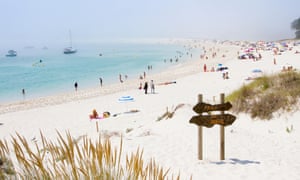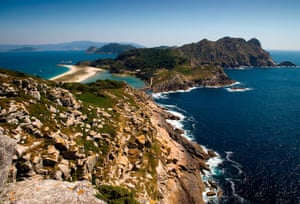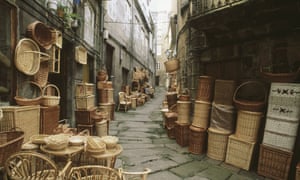 |
| Praia knowledge … Rodas beach, on the Cíes Islands near Vigo. Photograph: Alamy |
New direct flights to Vigo, on the coast of Galicia, bring the Caribbean-like beaches of the Cíes islands within easy reach. And there’s lots to enjoy in the newly confident city itself, too
On the wide crescent of soft white sand that stretched ahead as far as we could see, we spent a lazy afternoon sunbathing, occasionally cooling off in the clear sea. Earlier we had walked through low cloud and lush forest, explored hidden coves and stopped to eat octopus at the island’s only restaurant. It could have been Barbuda. But the Caribbean is a good 10-hour flight away; this is just two hours by plane from London, plus a pleasant half-hour boat ride.
My friend and I were in Rodas bay, a contender for best beach in the world, on Monteagudo, one of the gorgeous Cíes islands in Galicia, northern Spain. The archipelago is also made up of San Martiño and Faro islands: the first is reachable only by private boat, but the other two are served by ferries from the city of Vigo, which can be reached by new direct flights with Air Nostrum (aka Iberia Regional) from Luton.
The islands are an easy day trip from Vigo, adding a relaxing beach element to your Spanish city break.
Few day trippers venture beyond this beautiful spot, though the two islands are joined by the Rodas sandbar that crosses a lagoon. It gets busy in summer, although visitor numbers to the two islands are limited to 2,200 a day as they are part of the wider Atlantic Islands of Galicia national park. Quieter, secluded beaches are within a short walk, and we visited sheltered Figueiras, 15 minutes away, which is great for swimming. More beaches dot the eastern side of the islands; the sea-facing side is wild and rocky. The national park status means visitors can walk only on four designated trails. My friend and I took route one (five miles) up to a high lighthouse – though the Atlantic mist had rolled in at the top.
It is also possible to holiday on the islands – by booking a stay on the shady 800-pitch campsite next to Rodas beach. This is where we had lunch, and it was a far cry from typical camping fare: the aforementioned octopus – a feast with potatoes, roasted peppers, olive oil and paprika – was cooked to the chef’s grandmother’s recipe. It was preceded by heaped plates of razor clams, and washed down with albariño, Galicia’s fresh, aromatic white wine.
Over on the mainland, there are yet more beaches: the Vigo area has 45 in total, starting next to San Miguel church in Bouzas, a fishing district 10 minutes’ drive from the centre, and extending about 10 miles south and west to Saians. Samil is the biggest, at just over a mile long, and the busiest, flanked by bars and play areas. Locals tend to head further out to quiet La Fontaíña, or Fortiñón, which is down a steep hill, but still lively, with a popular bar. A trip to Vigo offers much more than a beach break, however. It’s the biggest city in Galicia (although Santiago de Compostela is the capital), and was the fastest-growing in Europe in the 20th century. That rapid growth means the architecture is not as pleasingly homogenous as Santiago’s, but it also makes it a vibrant place where half a million people live, work and study.
The hilly old town has evocatively named streets that still fulfil their original functions: you can buy oysters on Calle de las Ostras, hats on Sombrereiros and baskets on Cesteiros. Old taverns sell beer for a euro; wine bars serve glasses of albariño or young, acidic reds. Tapas bars specialise in seafood, said to be the best in Spain thanks to the water temperature and the type of plankton that abounds here. Octopus is ubiquitous, but there’s also baby squid, grilled sardines andchinchos (small fried fish).
Tradition is alive and well in the casco vello (old town), but a wave of new bars, restaurants and shops have opened recently, as young people have been drawn to the area by preferential rents. A tiny street once the centre of the red-light district is now home to Matina (Rúa Abeleira Menéndez 26), an organic coffee shop that also sells clothes, furniture and art; a wine shop has just opened next door.Artemar (Rúa Gamboa 20) is a new tapas bar serving high-quality tinned fish, a major trend in Spain; Nos (Rua Palma 3) is a hip microcerveceria; and La Pulpería de Maruja (Rua da Laxe 9) a new casual venture from the Michelin-starredMaruja Limón restaurant.
Elsewhere, each district has its charms, from earthy Bouzas to the grand waterfront. The latter was transformed in the late 1990s, when the Opening Vigo to the Sea project created new promenades, gardens and squares. The tourist office arranges dawn tours of the Lonja de Vigo (fish market) for early risers who want to witness the fish auctions. Even the unprepossessing area around the station is worth a visit, thanks to the fantastic Follas Novas restaurant (Calle de Serafín Avendaño 10). The lighting is bright, the decor basic, but the scrambled egg with sea urchin was unlike anything I’ve ever eaten: musky yet sweet, briny but creamy.
Attention is now turning to the beach area, where the excellent Museo do Mar(Avenida da Atlántida 160, museodomar.com/es) has opened in a restored cannery. Further on, the new Cíes Marina Beach Club (Avenida de Samil 30) is a swanky place for a sundowner. The multimillion-euro venue, opened by a local businessman last month, is confident and ambitious, a fitting symbol of modern Vigo.
There are pleasant pockets of green, too. I wandered through Parque del Castro’s botanical gardens and Roman remains, crowned by a 17th-century fort with panoramic views (accessed from Plaza de España or Avenida das Camelias). Parque de Castrelos contains the Museo Quiñones de León, the city’s main museum and gallery, in a 17th-century stately home. Here, too, the Castrelos Auditorium, a Roman-style amphitheatre, hosts summer gigs – Franz Ferdinand and Primal Scream have played here. Finally, there is a 35-mile nature trail along the hilltops that surround the city, the GR53.
Accommodation is still quite limited. Gran Hotel Nagari is a slick boutique hotel on leafy Plaza de Compostela, a 19th-century boulevard close to the waterfront, but room-only rates are just that, and don’t even include use of the rooftop pool. Another option is Hotel Marco, a double room behind the modern art gallery created as an art project but available for stays (€100 B&B, Príncipe 54,marcovigo.com). Or there is always that island campsite (pitch €7.50 plus €7pp,campingislascies.com, right next to the best beach this side of the Caribbean.
• Accommodation was provided by Gran Hotel Nagari (doubles from €94,granhotelnagari.com). For further information visit turismodevigo.org/en
By Rachel Dixon, www.theguardian.com




No comments:
Post a Comment